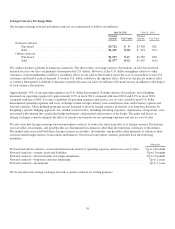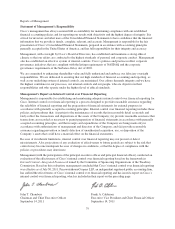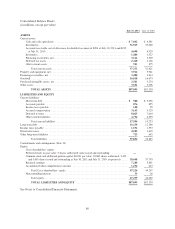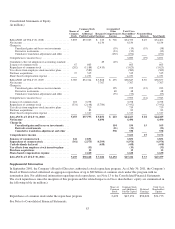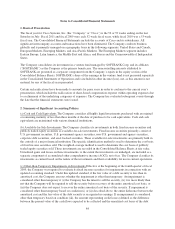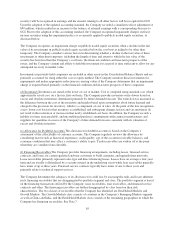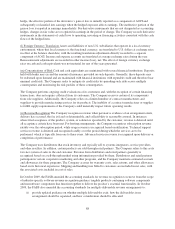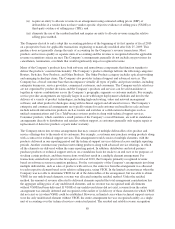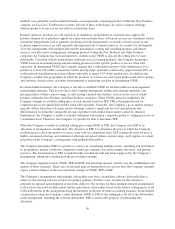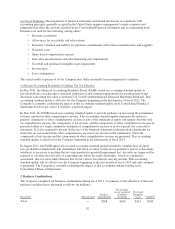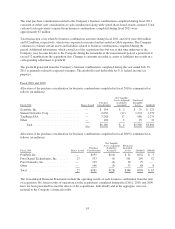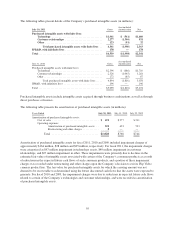Cisco 2011 Annual Report Download - page 94
Download and view the complete annual report
Please find page 94 of the 2011 Cisco annual report below. You can navigate through the pages in the report by either clicking on the pages listed below, or by using the keyword search tool below to find specific information within the annual report.The Company determines the allowance for credit loss for each class of financing receivables by applying the
loss factor based on a given internal credit risk rating assigned to each financing receivables class. The loss factor
is developed using external data as benchmarks, such as the external long-term historical loss rates and expected
default rates that are published annually by a major third party credit-rating agency. Internal credit risk rating is
derived by taking into consideration various customer-specific factors and macroeconomic conditions. These
factors include the strength of the customer’s business and financial performance, the quality of the customer’s
banking relationships, the Company’s specific historical experience with the customer, the performance and
outlook of the customer’s industry, the customer’s legal and regulatory environment, the potential sovereign risk
of the geographic locations in which the customer is operating, and independent third-party evaluations. Such
factors are updated regularly or when facts and circumstances indicate that an update is deemed necessary. The
Company’s internal credit risk ratings are categorized as 1 through 10 with the lowest credit risk rating
representing the highest quality financing receivables.
Receivables with a risk rating of 8 or higher are deemed to be impaired and are subject to impairment evaluation.
When evaluating lease and loan receivables and the earned portion of financed service contracts for possible
impairment, the Company considers historical experience, credit quality, age of the receivable balances, and
economic conditions that may affect a customer’s ability to pay. When the Company, based on current
information and events, determines that it is probable that all amounts due, including scheduled interest
payments, pursuant to the contractual terms of the financing agreement are unable to be collected, the financing
receivable is considered impaired. All such outstanding amounts, including any accrued interest, are assessed at
the customer level and will be fully reserved. Financing receivables are written off at the point when they are
considered uncollectible and all outstanding balances, including any previously earned but uncollected interest
income, will be reversed and charged against earnings. The Company does not typically have any partially
written-off financing receivables.
Outstanding financing receivables that are aged 31 days or more from the contractual payment date are
considered past due. The Company does not accrue interest on financing receivables that are considered impaired
or more than 90 days past due unless either the receivable has not been collected due to administrative reasons or
the receivable is well secured. Financing receivables may be placed on non-accrual status earlier if, in
management’s opinion, a timely collection of the full principal and interest becomes uncertain. After a financing
receivable has been categorized as non-accrual, interest will be recognized when cash is received. A financing
receivable may be returned to accrual status after all of the customer’s delinquent balances of principal and
interest have been settled and the customer remains current for an appropriate period.
The Company facilitates third-party financing arrangements for channel partners, consisting of revolving short-
term financing, generally with payment terms ranging from 60 to 90 days. In certain instances, these financing
arrangements result in a transfer of the Company’s receivables to the third party. The receivables are
derecognized upon transfer, as these transfers qualify as true sales, and the Company receives a payment for the
receivables from the third party based on the Company’s standard payment terms. These financing arrangements
facilitate the working capital requirements of the channel partners and, in some cases, the Company guarantees a
portion of these arrangements. The Company also provides financing guarantees for third-party financing
arrangements extended to end-user customers related to leases and loans, which typically have terms of up to
three years. The Company could be called upon to make payments under these guarantees in the event of
nonpayment by the channel partners or end-user customers. Deferred revenue relating to these financing
arrangements is recorded in accordance with revenue recognition policies or for the fair value of the financing
guarantees.
86


